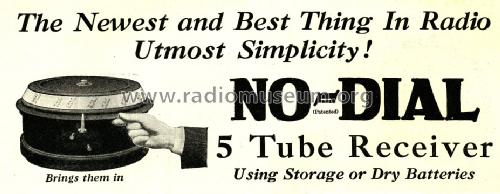No Dial 5 and 5D
Ohio Stamping & Engineering Co.; Dayton, Ohio
- Country
- United States of America (USA)
- Manufacturer / Brand
- Ohio Stamping & Engineering Co.; Dayton, Ohio
- Year
- 1925
- Category
- Broadcast Receiver - or past WW2 Tuner
- Radiomuseum.org ID
- 49780
-
- Brand: No-Dial
- Number of Tubes
- 5
- Valves / Tubes
- Main principle
- TRF (Tuned-Radio-Frequency but use of regeneration unknown)
- Wave bands
- Broadcast only (MW).
- Power type and voltage
- Storage and/or dry batteries
- Loudspeaker
- - This model requires external speaker(s).
- from Radiomuseum.org
- Model: No Dial 5 and 5D - Ohio Stamping & Engineering Co
- Shape
- Miscellaneous shapes - described under notes.
- Dimensions (WHD)
- 16 x 9 x 0 inch / 406 x 229 x 0 mm
- Notes
- One dial (primary tuning control knob) ; Das Gerät ist zylinderförmig. Es handelt sich um einen "Dial-less-Receiver". Die Senderwahl erfolgt durch Drehen des Deckels.
- Price in first year of sale
- 98.00 $
- External source of data
- Ernst Erb
- Source of data
- Radio Collector`s Guide 1921-1932
- Literature/Schematics (2)
- Radio Broadcast, May 1926, p. 31
- Other Models
-
Here you find 1 models, 1 with images and 0 with schematics for wireless sets etc. In French: TSF for Télégraphie sans fil.
All listed radios etc. from Ohio Stamping & Engineering Co.; Dayton, Ohio
Forum contributions about this model: Ohio Stamping &: No Dial 5 and 5D
Threads: 1 | Posts: 1
How the "dial-less" receiver is tuned
From "New Ideas In Receivers" by G.C.B. Rowe, 1925 (Extract)
The adjustment is made by rotating the cover of the set. Attached to the knurled knob shown in the center of this movable cover is a pin attended to a rotating shaft which controls two variable condensers that tune the one stage of radio frequency amplification and the detector unit. There are 5 tubes used. As mentioned above, there is one stage of radio frequency amplification, detector and three stages of audio frequency amplification, the last two of these being resistance coupled.

The rotating cover is removable. Under this there is a sub-panel of wood on which is mounted an adjustable resistance and the top of a rheostat. As may be seen, the vacuum tubes are inserted through this panel with their tips just clearing the movable cover. Once the rheostats are set, they need no further adjustment and so are hidden by the cover.

How the set operates. The spindle (1) turned by the cover rotates gear (A). This turns the upper condenser and also the lower condenser through the floating gear train (B) and (C). Lever (4) equalizes the capacities and (3) controls the rheostats.
On the side of the set are two handles; one controls the volume and the other is an adjustment for the variable condensers. The volume control lever, when placed on left side of the slot, disconnects the "A" battery from the filaments of the tubes, and when moved across to the right side, operates a rheostat that controls the filament current. The second lever moves one of the two variable condensers through a system of gears so that the movable plates of the condensers can be placed in such a position that they compensate for any changes in the radio frequency transformer or the fixed coupler. When the movable plates of one condenser are set in relation to the plates of the other, the settings remain in fixed relation throughout the whole range of capacity.

The revolving cover is supported by the plate (1) which is attached to the shaft to which is fastened the variable condenser gear. The pointer (2) indicates the call letters written on the rim of the cover. The controls (3) and (4) are the condenser phase adjustment and volume control respectively.
Around the perimeter of the cover is a flat, gilded strip on which may be written the call letters of different stations. As each station will come in at a different point on the perimeter of the cover, there is sufficient space for a great number of call letters.
Karlheinz Gützlaff, 27.Feb.10







